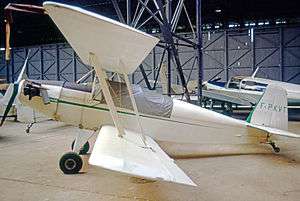Indraéro Aéro 101
The Indraéro Aéro 101 was a light training biplane developed in France in the 1950s.
| Aéro 101 and Aéro 110 | |
|---|---|
 | |
| Aero 101 at Mitry-Mory airfield, near Paris, in June 1971 | |
| Role | Civil trainer |
| National origin | France |
| Manufacturer | Indraéro |
| Designer | Jean Chapeau and J. Blanchet |
| First flight | 27 July 1951 |
| Status | three examples active in 2009 |
| Primary user | SALS |
| Number built | ca 13 |
Design and service
It was a conventional design with single-bay staggered wings braced with an I-strut, and fixed tailskid undercarriage with divided main units. The pilot and instructor sat in tandem, open cockpits. A small batch of aircraft were ordered by SALS for aeroclub use.
The prototype, known as the Aéro 110, differing from the later production Aero 101s by having a welded steel tube fuselage and a 34 kW (45 hp) Salmson 9ADb radial engine, first flew on 1 May 1950
Operational history
Three examples of the type were current on the French Civil Aircraft Register in 2009, including an Aero 101C and two Aero 101s.[1]
Variants
- Aéro 110
- Prototype of the Aero 101 with welded steel tube fuselage and Salmson 9ADb radial engine first flown on 1 May 1950, 1 built.
- Aéro 101
- Ten production aircraft built with wooden structure and powered by Minié 4.DC.32 engines, first flown on 27 July 1951.
- Aéro 101C
- At least one aircraft fitted with a 48 kW (65 hp) Continental A65.
Specifications (Aéro 101)
Data from [2]
General characteristics
- Crew: 2
- Length: 5.6 m (18 ft 4 in)
- Wingspan: 7.6 m (24 ft 11 in)
- Height: 2.2 m (7 ft 3 in)
- Wing area: 14.0 m2 (151 sq ft)
- Empty weight: 312 kg (688 lb)
- Gross weight: 505 kg (1,113 lb)
- Powerplant: 1 × Minié 4.DC.32 4-cyl. air-cooled horizontally-opposed piston engine, 56 kW (75 hp)
Performance
- Maximum speed: 178 km/h (111 mph, 96 kn)
gollark: Yes. It's also imperative and unpleasant.
gollark: Most of the concepts transfer between them fine.
gollark: Yeeees.
gollark: ... `innerText`, if you must.
gollark: Generally, don't set innerHTML directly? Escape user input, but you might forget, so probably use a JS framework which handles it for you. I like mithril.js, it is fairly lightweight. Svelte is also cool.
References
- Partington, 2009, pp 183-224
- Parmentier, Bruno. "Indraéro Aéro 101". Retrieved 6 December 2013.
Bibliography
- Taylor, Michael J. H. (1989). Jane's Encyclopedia of Aviation. London: Studio Editions. p. 534.
- Simpson, R. W. (1995). Airlife's General Aviation. Shrewsbury: Airlife Publishing. pp. 424–25.
- Partington, Dave (2009). European Registers Handbook 2009. Tonbridge, Kent: Air-Britain (Historians) Ltd. ISBN 978-0-85130-417-5.
This article is issued from Wikipedia. The text is licensed under Creative Commons - Attribution - Sharealike. Additional terms may apply for the media files.